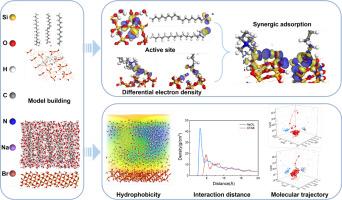Interfacial interaction mechanisms of cationic–anionic mixed collectors on quartz surfaces: A combined density functional theory and molecular dynamics study
IF 6.3
2区 材料科学
Q2 CHEMISTRY, PHYSICAL
引用次数: 0
Abstract
This study investigates the synergistic adsorption mechanism of anionic/cationic mixed collectors on quartz surfaces to enhance the flotation separation of low-grade quartz. Combining density functional theory (DFT) and molecular dynamics (MD), we systematically analyzed the adsorption behavior of dodecylamine (DDA), sodium oleate (NaOL), and cetyltrimethylammonium bromide (CTAB) as single and mixed collectors, with emphasis on electronic structure, molecular configuration, and interfacial properties. DFT calculations revealed that the cationic CTAB exhibited the highest adsorption energy among the single collectors. The introduction of the anionic NaOL further reduced the adsorption energy, demonstrating a significant synergistic effect. MD simulations of different mixing ratios of cationic-anionic mixed collectors reveal that the optimal ratio is 2:16 for DDA and NaOL, and 9:9 for CTAB and NaOL, which significantly alter the interfacial hydrophobicity. This multi-scale approach, spanning from electronic to molecular to interfacial levels, elucidates the enhanced flotation mechanism of mixed collectors, providing a theoretical basis for the efficient separation and resource utilization of low-grade quartz.

石英表面阳离子-阴离子混合捕集剂的界面相互作用机制:密度泛函理论与分子动力学的结合研究
研究了阴离子/阳离子混合捕收剂在石英表面的协同吸附机理,以促进低品位石英的浮选分离。结合密度功能理论(DFT)和分子动力学(MD),系统分析了十二烷基胺(DDA)、油酸钠(NaOL)和十六烷基三甲基溴化铵(CTAB)作为单一和混合捕收剂的吸附行为,重点研究了它们的电子结构、分子构型和界面性质。DFT计算表明,阳离子CTAB在单个捕收剂中表现出最高的吸附能。阴离子NaOL的引入进一步降低了吸附能,显示出显著的协同效应。MD模拟结果表明,DDA和NaOL的最佳混合比例为2:16,CTAB和NaOL的最佳混合比例为9:9,其界面疏水性显著改变。从电子到分子再到界面的多尺度研究,阐明了混合捕收剂的强化浮选机理,为低品位石英的高效分离和资源利用提供了理论依据。
本文章由计算机程序翻译,如有差异,请以英文原文为准。
求助全文
约1分钟内获得全文
求助全文
来源期刊

Surfaces and Interfaces
Chemistry-General Chemistry
CiteScore
8.50
自引率
6.50%
发文量
753
审稿时长
35 days
期刊介绍:
The aim of the journal is to provide a respectful outlet for ''sound science'' papers in all research areas on surfaces and interfaces. We define sound science papers as papers that describe new and well-executed research, but that do not necessarily provide brand new insights or are merely a description of research results.
Surfaces and Interfaces publishes research papers in all fields of surface science which may not always find the right home on first submission to our Elsevier sister journals (Applied Surface, Surface and Coatings Technology, Thin Solid Films)
 求助内容:
求助内容: 应助结果提醒方式:
应助结果提醒方式:


